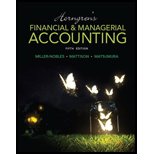
Horngren's Financial & Managerial Accounting (5th Edition)
5th Edition
ISBN: 9780133866292
Author: Tracie L. Miller-Nobles, Brenda L. Mattison, Ella Mae Matsumura
Publisher: PEARSON
expand_more
expand_more
format_list_bulleted
Concept explainers
Textbook Question
Chapter 13, Problem 8QC
A small stock dividend
a. decreases common stock.
b. has no effect on total equity.
c. increases
d. Items a, b, and c are correct.
Expert Solution & Answer
Want to see the full answer?
Check out a sample textbook solution
Students have asked these similar questions
Need help with this accounting questions
I want to correct answer general accounting question
Please give me answer general accounting question
Chapter 13 Solutions
Horngren's Financial & Managerial Accounting (5th Edition)
Ch. 13 - Prob. 1QCCh. 13 - Prob. 2QCCh. 13 - Suppose Value Home and Garden Imports issued...Ch. 13 - Prob. 4QCCh. 13 - Prob. 5QCCh. 13 - Assume that a company paid 6 per share to purchase...Ch. 13 - Prob. 7QCCh. 13 - A small stock dividend a. decreases common stock....Ch. 13 - Jackson Health Foods has 8,000 shares of 2 par...Ch. 13 - Prob. 10QC
Ch. 13 - Prob. 1RQCh. 13 - Prob. 2RQCh. 13 - How does authorized stock differ from outstanding...Ch. 13 - What are the four basic rights of stockholders?Ch. 13 - How does preferred stock differ from common stock?Ch. 13 - Prob. 6RQCh. 13 - What are the two basic sources of stockholders'...Ch. 13 - Prob. 8RQCh. 13 - If stock is issued for assets other than cash,...Ch. 13 - Prob. 10RQCh. 13 - Where and how is treasury stock reported on the...Ch. 13 - What is the effect on the accounting equation when...Ch. 13 - What are the three relevant dates involving cash...Ch. 13 - How does cumulative preferred stock differ from...Ch. 13 - What is a stock dividend?Ch. 13 - Prob. 16RQCh. 13 - What are some reasons corporations issue stock...Ch. 13 - Prob. 18RQCh. 13 - What does the statement of retained earnings...Ch. 13 - What is a prior-period adjustment?Ch. 13 - Prob. 21RQCh. 13 - What does earnings per share report, and how is it...Ch. 13 - What is the price/earnings ratio, and how is it...Ch. 13 - What does the rate of return on common stock show,...Ch. 13 - Prob. 13.1SECh. 13 - Journalizing issuance of stock- at par and at a...Ch. 13 - Journalizing issuance of stock-no-par Ashford...Ch. 13 - Journalizing issuance of stock- stated value...Ch. 13 - Journalizing issuance o f stock for assets other...Ch. 13 - Prob. 13.6SECh. 13 - Accounting for cash dividends Frenchroast Company...Ch. 13 - Dividing cash dividends between preferred and...Ch. 13 - Prob. 13.9SECh. 13 - Prob. 13.10SECh. 13 - Prob. 13.11SECh. 13 - Preparing a statement of retained earnings Tinder,...Ch. 13 - Analyzing the effect of prior-period adjustments...Ch. 13 - Prob. 13.14SECh. 13 - Prob. 13.15SECh. 13 - Prob. 13.16SECh. 13 - Prob. 13.17ECh. 13 - Prob. 13.18ECh. 13 - Journaling issuance of stock Skylar Systems...Ch. 13 - Prob. 13.20ECh. 13 - Prob. 13.21ECh. 13 - Prob. 13.22ECh. 13 - Journalizing treasury stock transactions and...Ch. 13 - Journalizing issuance of s tock and treasury stock...Ch. 13 - Computing dividends on preferred and common stock...Ch. 13 - Computing dividends on preferred and common stock...Ch. 13 - Journalizing a stock dividend and reporting...Ch. 13 - Prob. 13.28ECh. 13 - Reporting stockholders' equity after a stock split...Ch. 13 - Determining the effects of cash dividends, stock...Ch. 13 - Prob. 13.31ECh. 13 - Prob. 13.32ECh. 13 - Computing earnings per share and price/earnings...Ch. 13 - Computing rate of return on common stockholders'...Ch. 13 - Organizing a corporation and issuing stock John...Ch. 13 - Identifying sources of equity, stock issuance, and...Ch. 13 - Prob. 13.37APCh. 13 - Journalizing dividends and treasury stock...Ch. 13 - Journalizing dividend and treasury stock...Ch. 13 - Prob. 13.40APCh. 13 - Prob. 13.41BPCh. 13 - Prob. 13.42BPCh. 13 - Prob. 13.43BPCh. 13 - Journalizing dividends and treasury stock...Ch. 13 - Journalizing dividend and treasury stock...Ch. 13 - Prob. 13.46BPCh. 13 - Sources of equity and journalizing stock issuance...Ch. 13 - Prob. 13.1CTFSCCh. 13 - Prob. 13.1CTCA
Knowledge Booster
Learn more about
Need a deep-dive on the concept behind this application? Look no further. Learn more about this topic, accounting and related others by exploring similar questions and additional content below.Similar questions
arrow_back_ios
SEE MORE QUESTIONS
arrow_forward_ios
Recommended textbooks for you
 Managerial AccountingAccountingISBN:9781337912020Author:Carl Warren, Ph.d. Cma William B. TaylerPublisher:South-Western College Pub
Managerial AccountingAccountingISBN:9781337912020Author:Carl Warren, Ph.d. Cma William B. TaylerPublisher:South-Western College Pub Cornerstones of Financial AccountingAccountingISBN:9781337690881Author:Jay Rich, Jeff JonesPublisher:Cengage Learning
Cornerstones of Financial AccountingAccountingISBN:9781337690881Author:Jay Rich, Jeff JonesPublisher:Cengage Learning Survey of Accounting (Accounting I)AccountingISBN:9781305961883Author:Carl WarrenPublisher:Cengage Learning
Survey of Accounting (Accounting I)AccountingISBN:9781305961883Author:Carl WarrenPublisher:Cengage Learning- Principles of Accounting Volume 1AccountingISBN:9781947172685Author:OpenStaxPublisher:OpenStax College
 Intermediate Financial Management (MindTap Course...FinanceISBN:9781337395083Author:Eugene F. Brigham, Phillip R. DavesPublisher:Cengage Learning
Intermediate Financial Management (MindTap Course...FinanceISBN:9781337395083Author:Eugene F. Brigham, Phillip R. DavesPublisher:Cengage Learning

Managerial Accounting
Accounting
ISBN:9781337912020
Author:Carl Warren, Ph.d. Cma William B. Tayler
Publisher:South-Western College Pub

Cornerstones of Financial Accounting
Accounting
ISBN:9781337690881
Author:Jay Rich, Jeff Jones
Publisher:Cengage Learning

Survey of Accounting (Accounting I)
Accounting
ISBN:9781305961883
Author:Carl Warren
Publisher:Cengage Learning

Principles of Accounting Volume 1
Accounting
ISBN:9781947172685
Author:OpenStax
Publisher:OpenStax College

Intermediate Financial Management (MindTap Course...
Finance
ISBN:9781337395083
Author:Eugene F. Brigham, Phillip R. Daves
Publisher:Cengage Learning
Dividend disocunt model (DDM); Author: Edspira;https://www.youtube.com/watch?v=TlH3_iOHX3s;License: Standard YouTube License, CC-BY